Atlanta Chinese Dance Company
presented
West to East, East to
West
on
Sunday, May 24, 2009 at 7:30 PM
Monday, May 25, 2009 at 2:00 PM
at
Performing Arts Center at Gwinnett Center
Duluth, Georgia
Staged and Directed by:
Hwee-Eng Y. Lee
Guest Artists:
Kerry Lee, H.T. Chen & Dancers
Tara Lee, Atlanta Ballet
Nadia Mara, Atlanta Ballet
Hangdong Xu, Dance China NY
Hoyi Chan
CELEBRATION OF LIFE: A COLLECTION OF CHINESE FOLK DANCES
“Celebration of Life” is a collection of
traditional Chinese folk dances based on celebratory events in Chinese culture.
Featured in this section are dances from the Han people, China’s ethnic
majority, as well as some of China’s fifty-five ethnic minorities such as the
Tibetan, Uyghur, Naxi, Dai, and Mongolian people. Each ethnic minority has
their own language and culture, and they also have a unique dance style.
HAN DANCE - CHINESE NEW YEAR
CELEBRATION
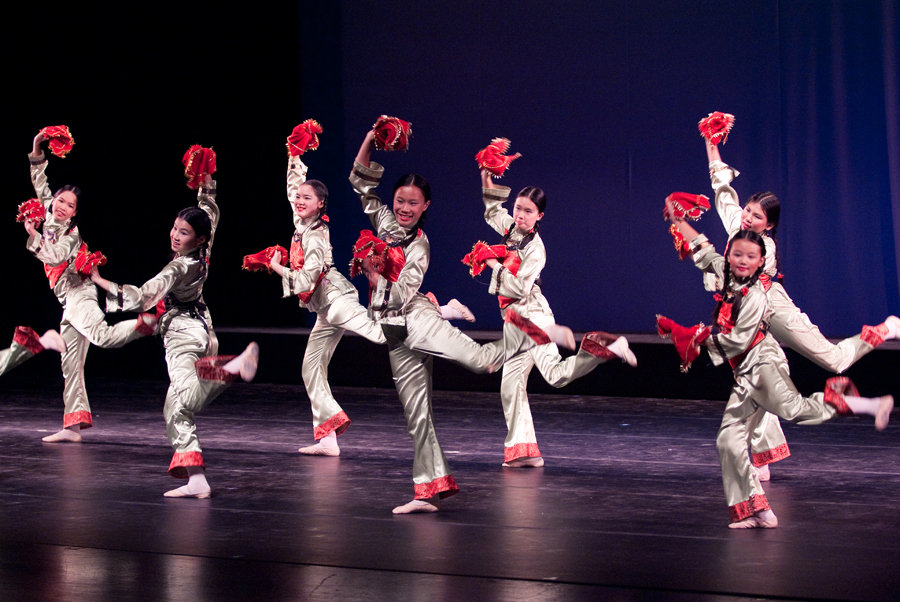
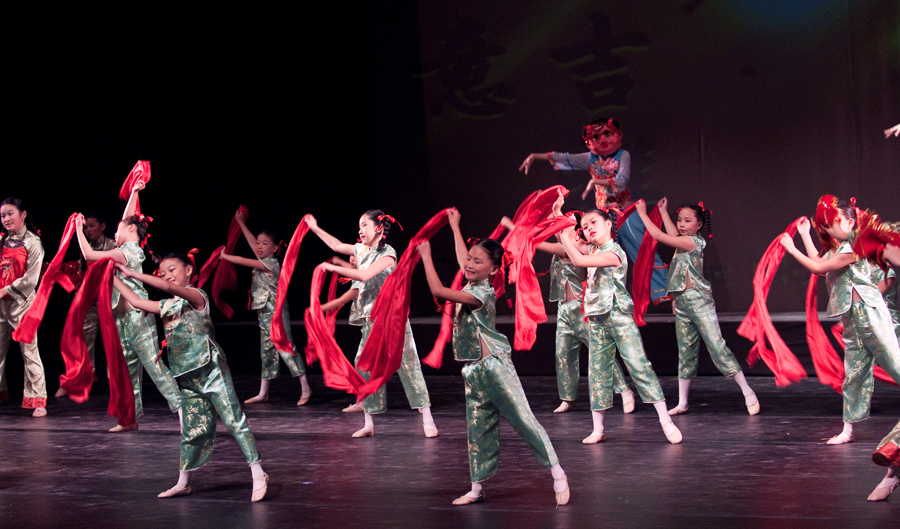 Chinese New
Year is one of the most important celebrations for the Han people. Every
household adorns their living quarters with red lanterns and ribbons, as red is
the symbol of happiness in Chinese culture. It is the most festive time of
year, and celebrations can last for as long as fifteen days. Joyous songs and
dances such as “yangge” create an exhilarating ambiance for all. “Yangge”
originated from farmers’ daily work movements and is the most representative
dance style of the Han Chinese folk people. Typical props of “yangge” include
ribbons, handkerchiefs, silk fans, and scarves. The dance style generally
expresses feelings of happiness. Additionally, big head dolls are often present
at celebrations to heighten the cheerfulness.
Chinese New
Year is one of the most important celebrations for the Han people. Every
household adorns their living quarters with red lanterns and ribbons, as red is
the symbol of happiness in Chinese culture. It is the most festive time of
year, and celebrations can last for as long as fifteen days. Joyous songs and
dances such as “yangge” create an exhilarating ambiance for all. “Yangge”
originated from farmers’ daily work movements and is the most representative
dance style of the Han Chinese folk people. Typical props of “yangge” include
ribbons, handkerchiefs, silk fans, and scarves. The dance style generally
expresses feelings of happiness. Additionally, big head dolls are often present
at celebrations to heighten the cheerfulness.
Choreographer: Hwee-Eng Y. Lee
Big Head Dolls: Alice Yee and Amy Yee
Ribbon
Dancers:
Yi-Shan Bernard, Mia I-Wah Chan, Sarah Anne Marie Goodwin, Camille Grough, Emma
Grough, Hilary Hsieh, Jade Leslie, Mia Mercaldo, Isabella Pu, Yannie Tan, Jesse
Wong, Kelsey Yao, Jessica Ye
Handkerchief Dancers:
Mei-Jing Bernard, Laura Brockmann, Ruby Freeman, Monica Ho, Lacey
Krakowiak, Rachel Leong, Anna Marianchuk, Alice Y. McCurley, Grace Rawden, Penny
Young
Photos by
Lily Photography
[Top of page]
TIBET DANCE - SOLO
 The Tibetan
people are one of
China’s
fifty-five minority ethnic groups. Tibetans mostly live in the Tibetan Plateau
(“Qing Zang Gaoyuan”) north of the Himalayas. Their economy is dominated by
subsistence agriculture, and they mostly believe in Tibetan Buddhism. Tibetan
clothing typically includes a multi-colored apron and long sleeves. Because the
weather can change rapidly in a single day, they often only wear one sleeve
during the day when the weather is warm.
The Tibetan
people are one of
China’s
fifty-five minority ethnic groups. Tibetans mostly live in the Tibetan Plateau
(“Qing Zang Gaoyuan”) north of the Himalayas. Their economy is dominated by
subsistence agriculture, and they mostly believe in Tibetan Buddhism. Tibetan
clothing typically includes a multi-colored apron and long sleeves. Because the
weather can change rapidly in a single day, they often only wear one sleeve
during the day when the weather is warm.
This dance depicts a young
lady walking on a snow-covered mountain, taking in the beautiful scenery around
her.
Choreographer: Minzu University of
China
Dancer: Queena Kou
Photos by
Lily Photography
[Top of page]
TIBET DANCE - PURE WHITE HADA
%20-%20CZ.jpg)
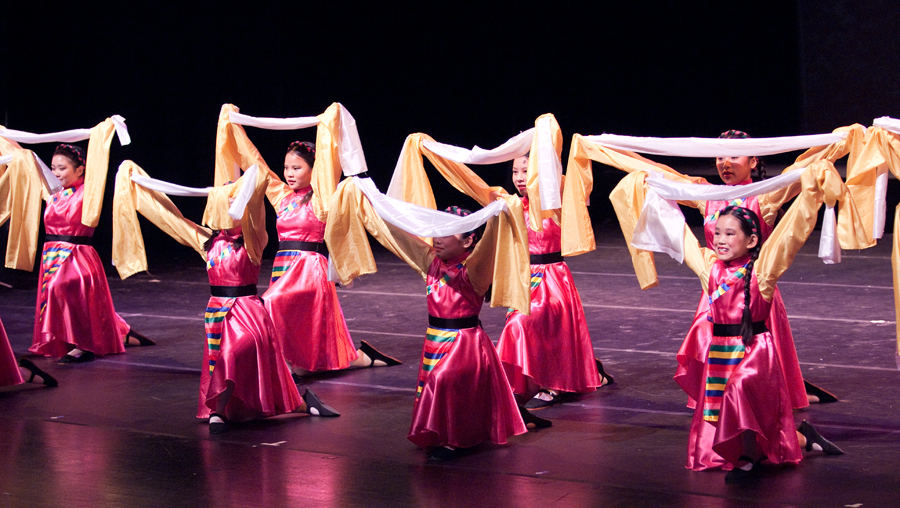 The
Tibetan people are one of
China’s
fifty-five minority ethnic groups. Tibetans mostly live in the Tibetan Plateau
(“Qing Zang Gaoyuan”) north of the Himalayas. Their economy is dominated
by subsistence agriculture, and they mostly believe in Tibetan Buddhism.
Tibetan clothing typically includes a multi-colored apron and long sleeves.
Because the weather can change rapidly in a single day, they often only wear one
sleeve during the day when the weather is warm.
The
Tibetan people are one of
China’s
fifty-five minority ethnic groups. Tibetans mostly live in the Tibetan Plateau
(“Qing Zang Gaoyuan”) north of the Himalayas. Their economy is dominated
by subsistence agriculture, and they mostly believe in Tibetan Buddhism.
Tibetan clothing typically includes a multi-colored apron and long sleeves.
Because the weather can change rapidly in a single day, they often only wear one
sleeve during the day when the weather is warm.
“Hada” is a white
scarf that is customarily presented as a gift by Tibetan people. During
weddings and funerals, Tibetan people use “hada” to pay their respects to
honorable guests. “Hada” symbolizes purity, loyalty, and respect.
Choreographer:
China Children’s
Shou-La-Shou Arts Troupe (Chongqing Branch)
Dancers: June
Brenner, Carolyn Butler, Freda Chen, Katherine Do, Andrew Ellis, Anna Grove,
Julie Hon, Genevieve Xiao Fei MacDonald, Nia Nguyen, Jade Phillips, Anna
Rappaport, Emily Reittinger, Emily Ye, Andrew Young
Photos by
Lily Photography (left) and Christine
Zahniser
[Top of page]
TIBET DANCE - SCHOOLGIRL AND THE DUCKS
%20-%20DJ.JPG) The Tibetan
people are one of
China’s
fifty-five minority ethnic groups. Tibetans mostly live in the Tibetan Plateau
(“Qing Zang Gaoyuan”) north of the Himalayas. Their economy is dominated by
subsistence agriculture, and they mostly believe in Tibetan Buddhism. Tibetan
clothing typically includes a multi-colored apron and long sleeves. Because the
weather can change rapidly in a single day, they often only wear one sleeve
during the day when the weather is warm.
The Tibetan
people are one of
China’s
fifty-five minority ethnic groups. Tibetans mostly live in the Tibetan Plateau
(“Qing Zang Gaoyuan”) north of the Himalayas. Their economy is dominated by
subsistence agriculture, and they mostly believe in Tibetan Buddhism. Tibetan
clothing typically includes a multi-colored apron and long sleeves. Because the
weather can change rapidly in a single day, they often only wear one sleeve
during the day when the weather is warm.
Set to a traditional Tibetan children’s song, this
dance portrays a young schoolgirl chasing a group of ducks.
Choreographer: Hwee-Eng Y. Lee
Schoolgirl: Sarah Anne Marie Goodwin (Sunday); Mia
Mercaldo (Monday)
Ducks: Madeleine Cannon,
Sophie Cannon, Kaya Chun, Cecilia Guterman, Alice Howting, Emma Mchale, Tailia
Ossip, Joline Speck, Julia Thao, Kara Thurston, Ashley Wang, Annie Wu
Photos by
Lily Photography
[Top of page]
NAXI DANCE - ALILI
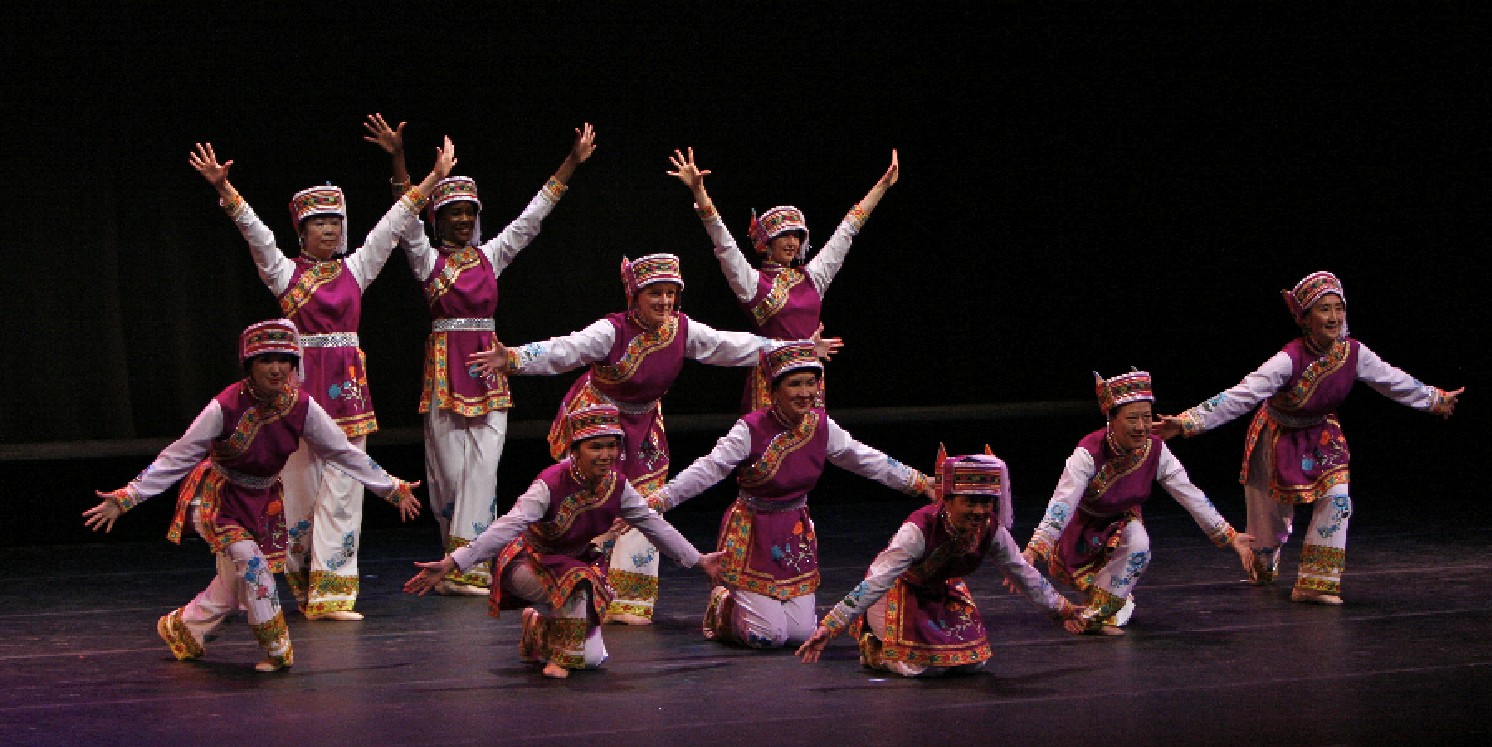 The
Naxi people, one of
China’s
fifty-five minority ethnic groups, live primarily at the intersection of the
Yunnan, Sichuan, and Tibetan provinces. Historically, they were part of the
Qiang minority ethnic group and lived in a matriarchal society. The dance
“Alili” is choreographed to a folk tune called “Hunting Dogs, Chasing Deers.”
The basic movement phrase consists of three steps and a lift of the foot. This
dance style has been passed down from generation to generation in Lijiang City
in northwestern Yunnan.
The
Naxi people, one of
China’s
fifty-five minority ethnic groups, live primarily at the intersection of the
Yunnan, Sichuan, and Tibetan provinces. Historically, they were part of the
Qiang minority ethnic group and lived in a matriarchal society. The dance
“Alili” is choreographed to a folk tune called “Hunting Dogs, Chasing Deers.”
The basic movement phrase consists of three steps and a lift of the foot. This
dance style has been passed down from generation to generation in Lijiang City
in northwestern Yunnan.
Choreographer: Traditional
Dancers:
Nancy Chen,
Debbie Ellis, Ludmilla Harker, Margery Hwang, Agate Lip, Tissa Sajoto, Iyabo
Shabazz, Shu Wu, Shu-Fen Yang, Zhiyong Zhao
Photo by Christine Zahniser
[Top of page]
UYGHUR DANCE - LIFT YOUR
VEIL
%20-%20CZ.jpg)
%20-%20CZ.jpg) One
of China’s fifty-five minority ethnic groups, the Uyghur people live primarily
in the Xinjiang Autonomous Region in northwest China. Because of their close
proximity to the
Middle East, most Uyghurs are followers of Islam.
Xinjiang is renowned for its fruit and produce, such grapes and melons. For
this reason, Uyghur dance often includes movements inspired by young ladies
picking grapes. Intricate neck and wrist movements are distinct characteristics
of their dance style.
One
of China’s fifty-five minority ethnic groups, the Uyghur people live primarily
in the Xinjiang Autonomous Region in northwest China. Because of their close
proximity to the
Middle East, most Uyghurs are followers of Islam.
Xinjiang is renowned for its fruit and produce, such grapes and melons. For
this reason, Uyghur dance often includes movements inspired by young ladies
picking grapes. Intricate neck and wrist movements are distinct characteristics
of their dance style.
Choreographer: Guangdong
Dance School
Dancer: Eugenie Ooi
Photos by Christine Zahniser
[Top of page]
UYGHUR DANCE - LUCKY TAMBOURINES
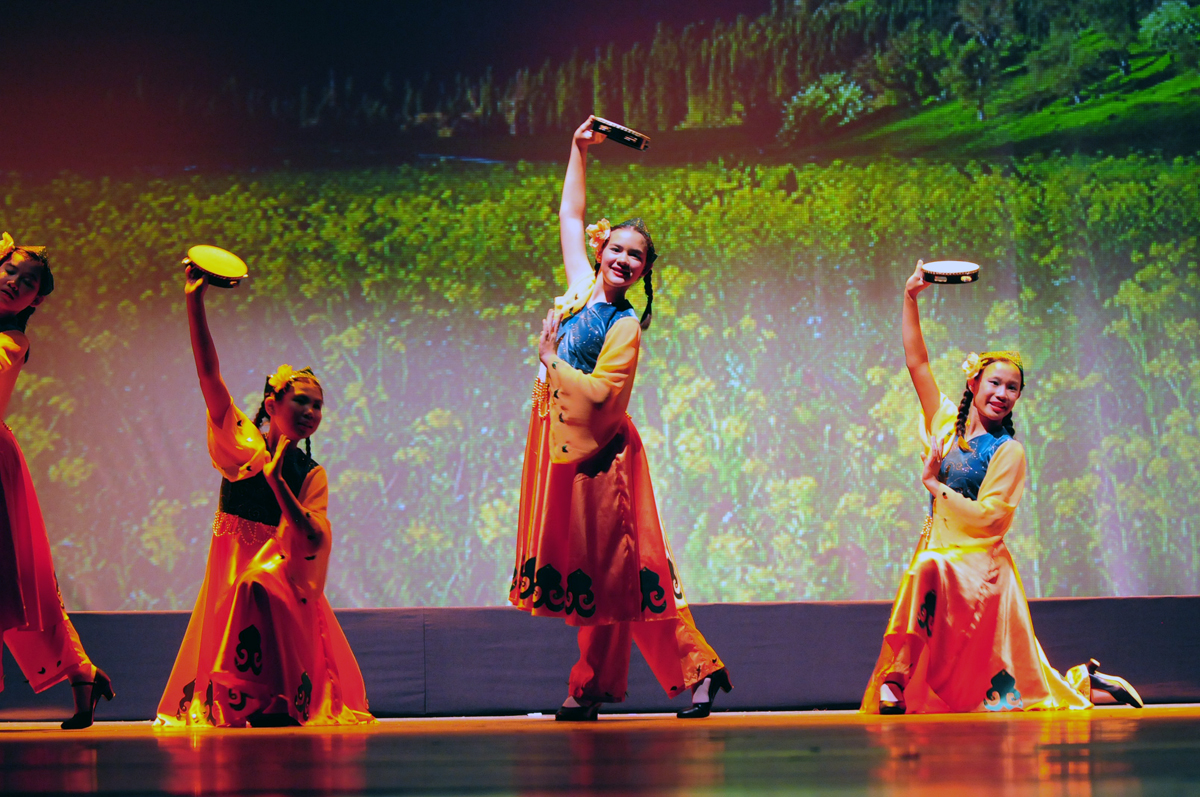
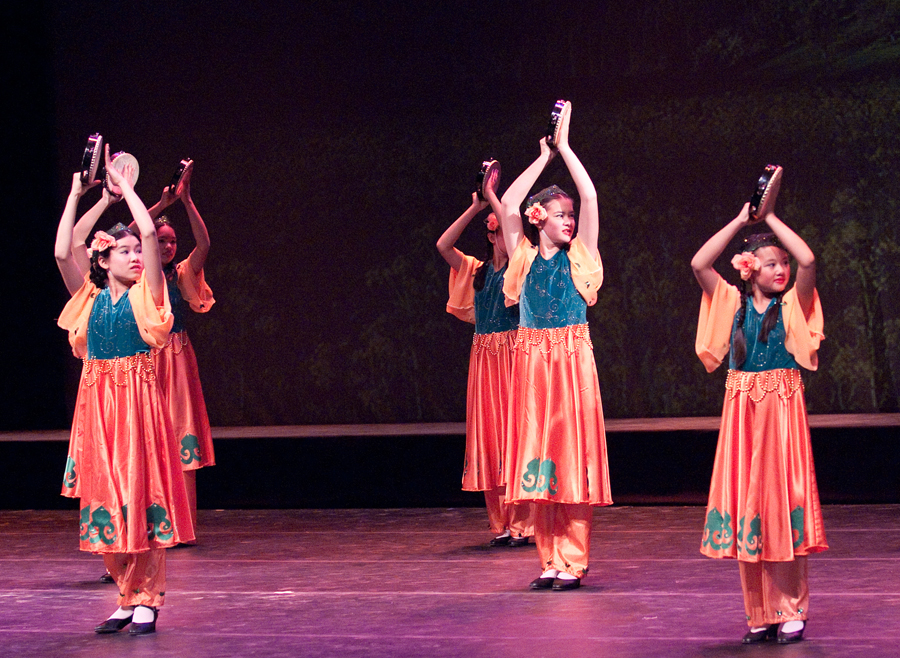 One of
China’s fifty-five minority ethnic groups, the Uyghur people live primarily in
the Xinjiang Autonomous Region in northwest China. Because of their close
proximity to the
Middle East, most Uyghurs are followers of Islam.
Xinjiang is renowned for its fruit and produce, such grapes and melons. For
this reason, Uyghur dance often includes movements inspired by young ladies
picking grapes. Intricate neck and wrist movements are distinct characteristics
of their dance style.
One of
China’s fifty-five minority ethnic groups, the Uyghur people live primarily in
the Xinjiang Autonomous Region in northwest China. Because of their close
proximity to the
Middle East, most Uyghurs are followers of Islam.
Xinjiang is renowned for its fruit and produce, such grapes and melons. For
this reason, Uyghur dance often includes movements inspired by young ladies
picking grapes. Intricate neck and wrist movements are distinct characteristics
of their dance style.
Choreographer: Nanjing City Little Swallow
Youth Arts Troupe
Dancers:
Mei-Jing Bernard, Laura Brockmann, Ruby Freeman, Monica Ho, Lacey Krakowiak,
Rachel Leong, Anna Marianchuk, Alice Y. McCurley, Grace Rawden, Penny Young
Photos by
Lily Photography (left) and Lander
Stoddard
[Top of page]
DAI DANCE - PEACOCK DANCE
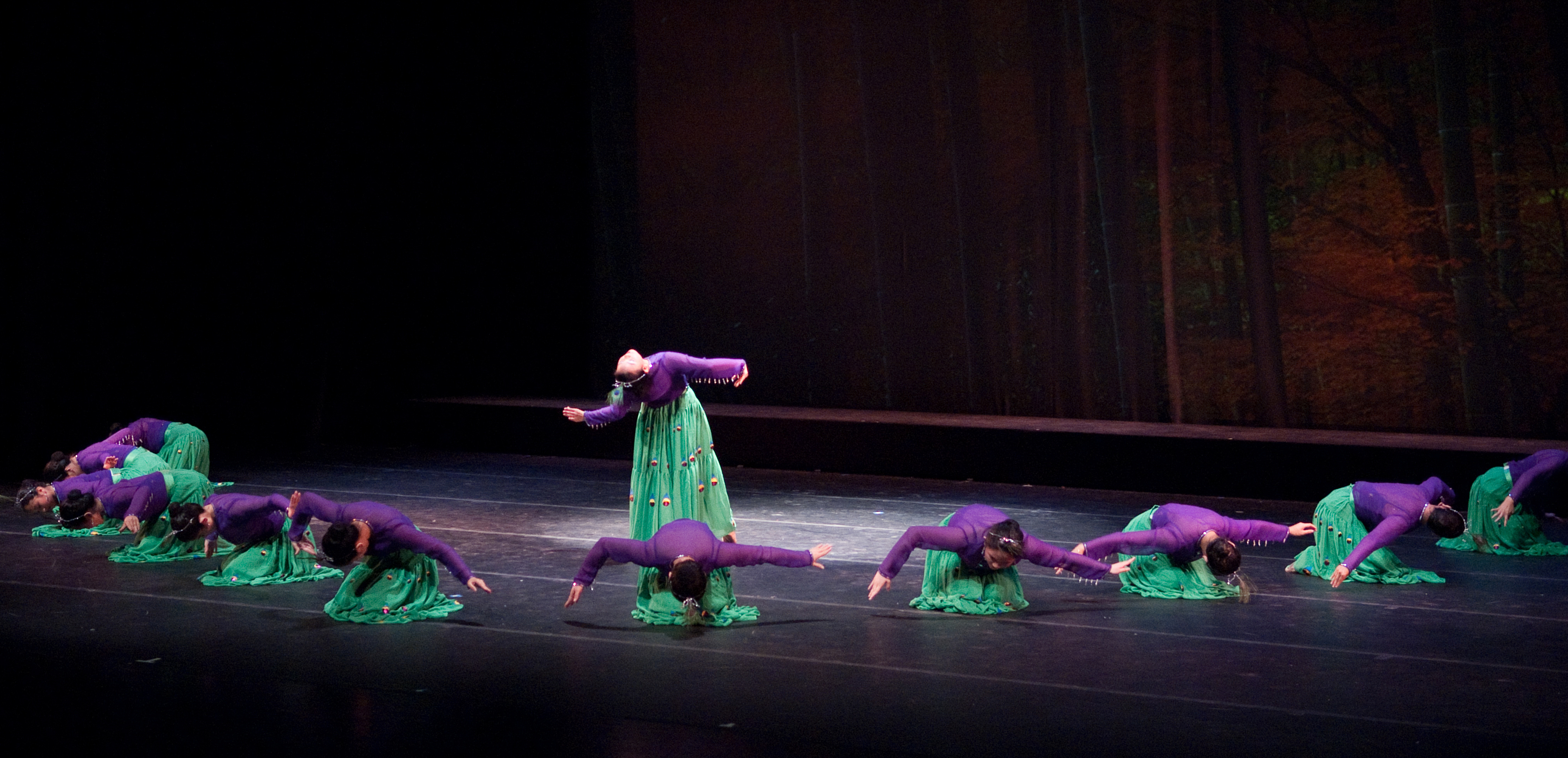
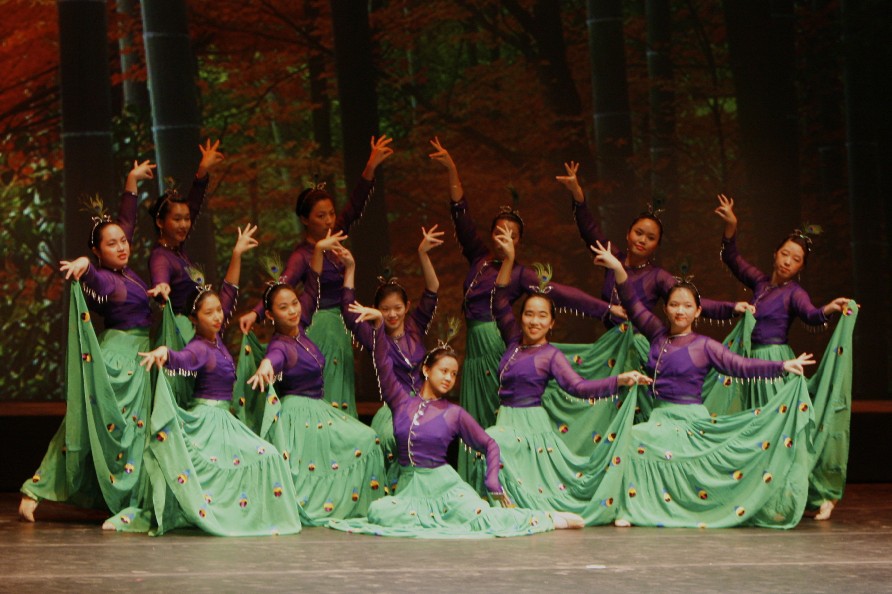 The
Dai people, who live primarily in the
Yunnan
province in southwest
China,
are one of China’s fifty-five minority ethnic groups. The Dai people adore
peacocks, which symbolize good luck and prosperity. This piece, which
incorporates Han classical arm movements, posture, and jumps with traditional
Dai folk dance, depicts a group of peacocks fanning their plumage, drinking
water, bathing, flying, and landing on trees. The complex formation changes
enhance the artistic expression of the piece. Traditional Dai dance movements
include angular arms and bouncy knees.
The
Dai people, who live primarily in the
Yunnan
province in southwest
China,
are one of China’s fifty-five minority ethnic groups. The Dai people adore
peacocks, which symbolize good luck and prosperity. This piece, which
incorporates Han classical arm movements, posture, and jumps with traditional
Dai folk dance, depicts a group of peacocks fanning their plumage, drinking
water, bathing, flying, and landing on trees. The complex formation changes
enhance the artistic expression of the piece. Traditional Dai dance movements
include angular arms and bouncy knees.
Choreographer: Jin Ming
Dancers:
Catherine Chu, Stephanie Hu, Jessica Kouch, Katie Ku, Allison Kwan, Alda Lee,
Tiffany Liu, Lindsey Lue, Tanya Su, Georgia Tse, Alice Yee, Amy Yee
Photo by Christine Zahniser (left) and
Lily Photography
[Top of page]
HAN DANCE - HARVEST
DANCE
%20-%20RN.JPG)
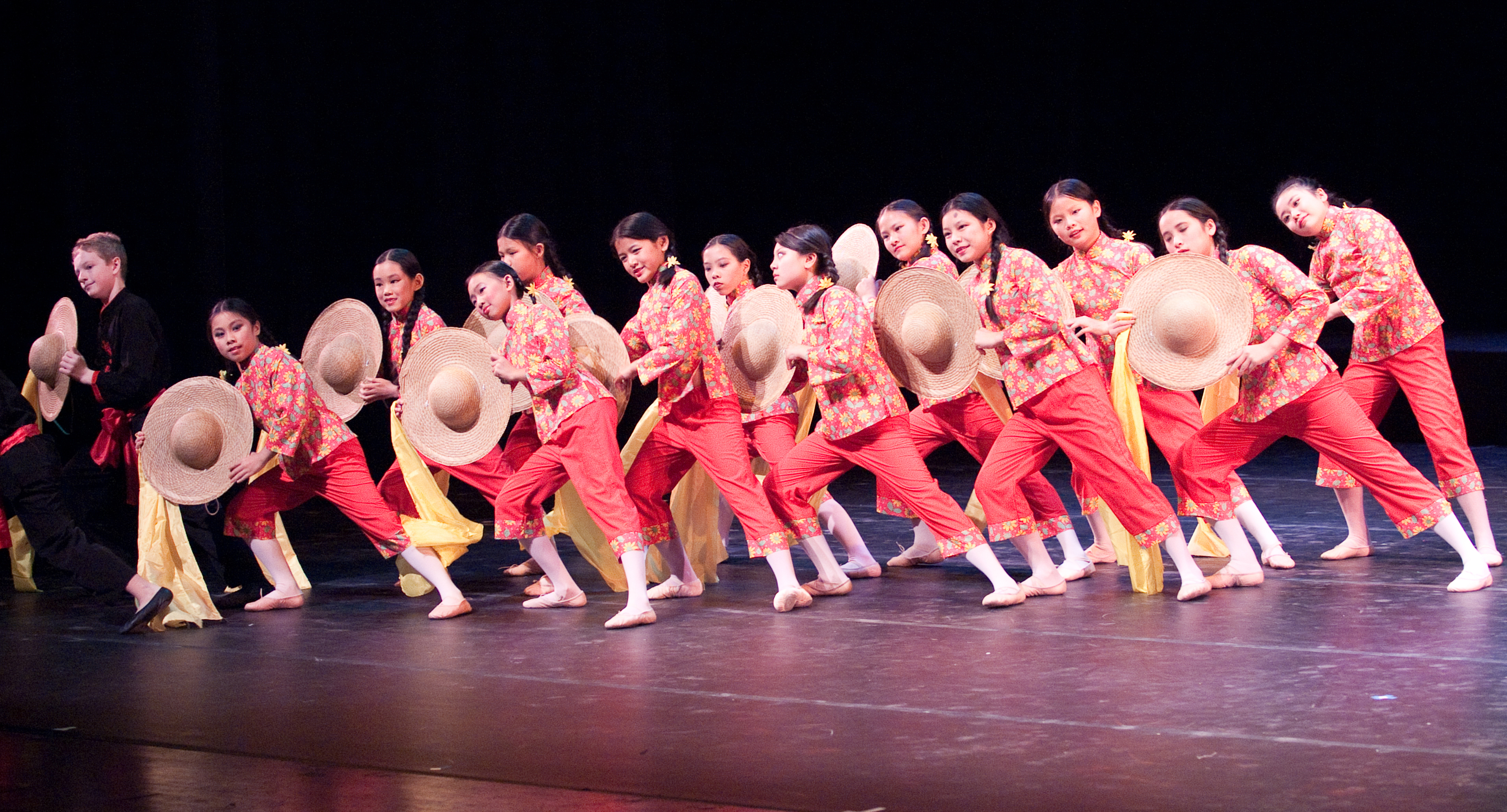 This
Han folk dance depicts a group of children harvesting their crops. The yellow
scarf symbolizes a “biandan,” or carrying pole, which the children use to carry
basket loads of rice. The dance depicts the diligent and energetic children
happily at work.
This
Han folk dance depicts a group of children harvesting their crops. The yellow
scarf symbolizes a “biandan,” or carrying pole, which the children use to carry
basket loads of rice. The dance depicts the diligent and energetic children
happily at work.
Choreographer: Hwee-Eng Y. Lee
Dancers:
June Brenner, Carolyn Butler, Freda Chen, Katherine Do, Andrew Ellis, Anna
Grove, Julie Hon, Genevieve Xiao Fei MacDonald, Nia Nguyen, Jade Phillips, Anna
Rappaport, Emily Reittinger, Emily Ye, Andrew Young
Photos by
Lily Photography (left) and
Nipdog Teleprompting
[Top of page]
MONGOLIAN DANCE - LUCKY CHOPSTICKS
%20-%20CZ.JPG)
%20-%20CZ.JPG)
Mongols,
one of China’s fifty-five minority ethnic groups, live a nomadic lifestyle on
the vast grasslands of the Inner Mongolia Autonomous Region of China. Their
dance style is influenced by their easy-going and bold character. Mongolian
chopsticks dances are usually performed as entertainment during celebratory
banquets. By using the chopsticks to hit their arms, hands, shoulders, back,
waist, legs, and the floor, they create interesting body percussion phrases. As
their passion escalates the rhythm of the dance increases, culminating in a
climactic, fast-paced ending.
Choreographer:
Beijing Xi Cheng
Youth Arts Troupe
Dancers:
Sophie Archer, Emily Backer, Marjorie Chamberlain, Christy Chang, Vera Chang,
Kateri Goodwin, Madeleine Morgan Lan Harris, Leslie Lue, Anna Meyer, Janie Wu,
Penny Young, Kate Zahniser-Word
Photos by Christine Zahniser
[Top of page]
HAN DANCE - WOMEN ON THAT SIDE OF
THE MOUNTAIN
%20-%20RN.JPG)
%20-%20CZ.JPG)
%20-%20CZ.jpg) This Han folk
dance depicts a group of honest, simple folk women enjoying a peaceful life
close the mountains. They gather together to reminisce their past weddings,
thinking back about how shy they were at the time. The choreography of this
dance was a winner of the China Central Television (CCTV) Dance Competition.
This Han folk
dance depicts a group of honest, simple folk women enjoying a peaceful life
close the mountains. They gather together to reminisce their past weddings,
thinking back about how shy they were at the time. The choreography of this
dance was a winner of the China Central Television (CCTV) Dance Competition.
Choreographer: Mo Binyu and Zhang Yinsong
Dancers:
Irene Chien (Lead – Sunday), Eugenie Ooi (Lead – Monday), Nancy Chen, Autumn
Coleman, Justina Ho, Chanie Howard, Margery Hwang, Queena Kou, Agate Lip, Angela
Liu, Emily Pau, Iyabo Shabazz, Julia Shyu, Melissa Ting, Shu Wu, Shu-Fen Yang,
Nora Yunfan Zhang, Zhiyong Zhao
Photos by Nipdog Teleprompting
(top left) and Christine Zahniser
[Top of page]
WEST TO EAST
The emergence of western dance forms such as ballet and modern dance in
China have greatly impacted the development of Chinese ballet and traditional
Chinese dance in China. Balletic influences such as pointed feet, turn out of
the legs, high extension, and ethereal quality can be observed in Chinese
ballets and Chinese dances of the late 20th and early 21st
centuries. In recent years, modern dance concepts such as creative
self-expression, freedom of movement, floor work, and sense of gravity have also
influenced the development of Chinese dance.
LU DAI DANG FENG
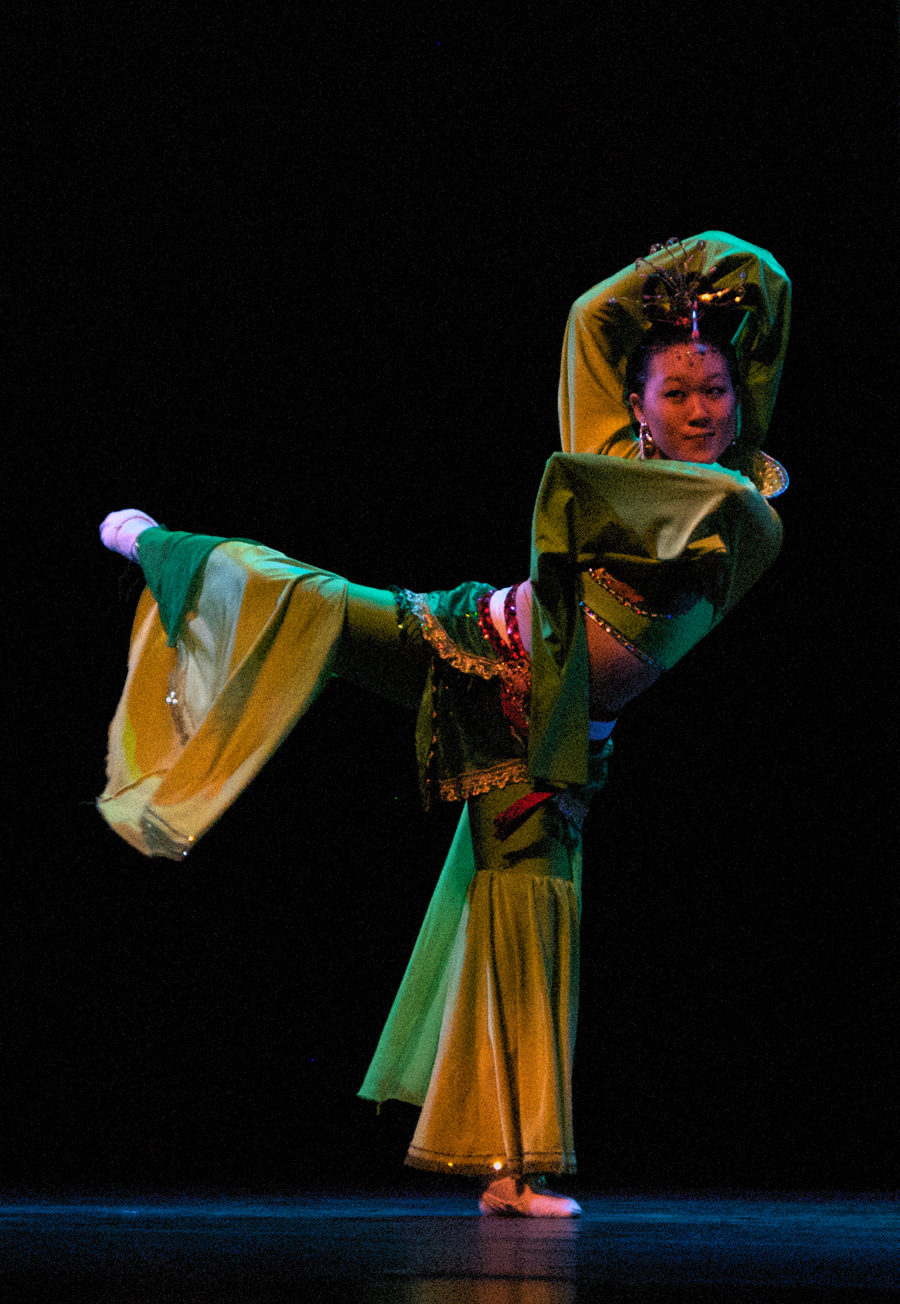
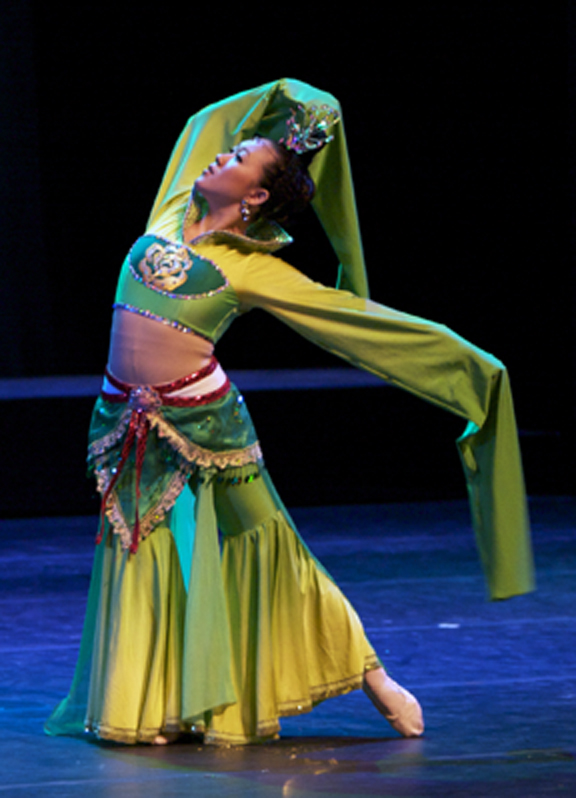 Chinese
classical dance originated primarily from Chinese opera and ancient mural
paintings. Dance scholars carefully researched these paintings and created
dance movements to imitate them. This Chinese classical dance piece
incorporates western dance styles such as ballet and modern dance. The
movements, while still rich in the Han classical dance tradition, are more
exaggerated and free.
Chinese
classical dance originated primarily from Chinese opera and ancient mural
paintings. Dance scholars carefully researched these paintings and created
dance movements to imitate them. This Chinese classical dance piece
incorporates western dance styles such as ballet and modern dance. The
movements, while still rich in the Han classical dance tradition, are more
exaggerated and free.
Choreographer:
Beijing Dance Academy
Dancer:
Hoyi Chan (Guest Artist)
Photo
by Nipdog Teleprompting (left) and Christine
Zahniser
[Top of page]
FLYING APSARAS

%20-%20CZ.jpg)
%20-%20CZ.jpg)
This Chinese
classical dance piece was inspired by the image of goddesses flying in heaven as
depicted in mural paintings in Dunhuang, a city in the Gansu province. These
paintings have been preserved in a cave since the Tang Dynasty (618-907), a time
in which Buddhism was introduced to China from India. Thus, Dunhuang dance was
influenced by classical Indian dance. It has now developed to be a unique dance
form. This piece incorporates technical ballet movements such as controlled
extensions and large jumps.
Choreographer:
Chen Ailian
Dancers:
Catherine Chu and Allison Kwan
Photos
by Nipdog Teleprompting (left) and Christine Zahniser
[Top of page]
EXCERPT FROM
WHITE-HAIRED GIRL: CHINESE NEW YEARS' EVE
%20-%20RN.jpg)
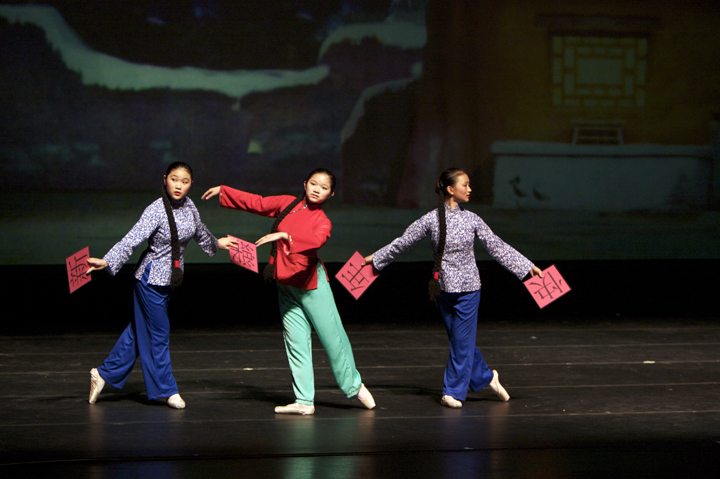 Chinese
ballet is a fusion of classical ballet technique with Chinese dance and opera
movement. In the 1950s, Russian artists brought Russian ballet training to
China and assimilated it with the Chinese training program for dancers. In
addition to performing classical ballets such as
Swan
Lake
and
Giselle,
China also created Chinese ballets to tell the stories of their own people.
White-haired Girl is a well-known Chinese ballet about a young peasant Xi’er
who flees to a cave to shield herself from her abusive landlord. Hardships
cause her hair to turn white, so she is nicknamed “White-haired Girl.”
Chinese
ballet is a fusion of classical ballet technique with Chinese dance and opera
movement. In the 1950s, Russian artists brought Russian ballet training to
China and assimilated it with the Chinese training program for dancers. In
addition to performing classical ballets such as
Swan
Lake
and
Giselle,
China also created Chinese ballets to tell the stories of their own people.
White-haired Girl is a well-known Chinese ballet about a young peasant Xi’er
who flees to a cave to shield herself from her abusive landlord. Hardships
cause her hair to turn white, so she is nicknamed “White-haired Girl.”
In this excerpt
Xi’er awaits her father’s return on Chinese New Years’ Eve. Her father has been
in hiding to escape the debt collector from their tyrannical landlord. Her
friends bring Chinese paper cuts to cheer her up.
Choreographer:
Shanghai Dance
School
Xi’er: Janie Wu
Xi’er’s Friends: Kateri Goodwin, Madeleine Morgan Lan Harris
Photo by Nipdog Teleprompting (left) and Christine
Zahniser
[Top of page]
EXCERPT FROM WHITE-HAIRED GIRL:
ESCAPE TO THE CAVE
%20-%20RN.jpg)
%20-%20RN.jpg)
%20-%20CZ.jpg)
Chinese ballet is
a fusion of classical ballet technique with Chinese dance and opera movement.
In the 1950s, Russian artists brought Russian ballet training to China and
assimilated it with the Chinese training program for dancers. In addition to
performing classical ballets such as
Swan
Lake
and
Giselle,
China also created Chinese ballets to tell the stories of their own people.
White-haired Girl is a well-known Chinese ballet about a young peasant Xi’er
who flees to a cave to shield herself from her abusive landlord. Hardships
cause her hair to turn white, so she is nicknamed “White-haired Girl.”
Xi’er’s father
eventually returns home and is killed by their landlord shortly thereafter. The
landlord takes Xi’er in as a concubine, and she is forced to work day and night
as a slave. After the landlord tries to rape her, Xi’er escapes in the night.
This excerpt shows her travels in the mountains where she eventually finds
shelter in a cave, fighting wolves and other beasts along the way.
Choreographer:
Shanghai Dance
School
Xi’er: Nadia Mara (Guest Artist,
Atlanta Ballet)
White-haired Girl: Tara Lee (Guest Artist, Atlanta Ballet)
Photo by Nipdog Teleprompting
(left and center) and Christine Zahniser
[Top of page]
RAIN IN A SMALL TOWN
LANE
%20-%20RN.jpg)
%20-%20CZ.jpg)
%20-%20RN.jpg)
This dance
depicts a group of young ladies walking through a rainy lane south of the
Yangtze River, an area of China also known as Jiangnan. The choreography, which
won the gold medal at the Fifth Lotus Dance Competition in
China,
shows the ladies playing in the rain. The gestures, such as lifting their
skirts, opening and closing their umbrellas, drying them off, or crossing a
bridge, are simple yet meaningful. Balletic influences can be seen through the
intricate footwork in the dance.
Choreographer:
Nanjing Military Dance Troupe
Umbrella Dancers: Irene Chien, Autumn Coleman, Justina Ho, Chanie Howard, Queena
Kou, Angela Liu, Eugenie Ooi, Emily Pau, Julia Shyu, Melissa Ting, Nora Yunfan
Zhang
Young Girl:
Kate-Zahniser
Word (Sunday), Sophie Archer (Monday)
Photo by Nipdog Teleprompting
(left and right) and Christine Zahniser
[Top of page]
CRADLE

 “Cradle,”
choreographed to music from the Chinese movie Xiao Hua (1980), depicts a
young pregnant woman full of hope at the dawn of a new
China.
She imagines her husband fighting courageously to defend their country. This
piece won an “Outstanding Choreography Award” at the most recent National Dance
Competition in
China.
Though it is categorized as Chinese folk dance and the content is Chinese, the
movement is strongly influenced by modern dance. Much of the movements have a
close relationship with the floor, which is defining quality of modern dance.
“Cradle,”
choreographed to music from the Chinese movie Xiao Hua (1980), depicts a
young pregnant woman full of hope at the dawn of a new
China.
She imagines her husband fighting courageously to defend their country. This
piece won an “Outstanding Choreography Award” at the most recent National Dance
Competition in
China.
Though it is categorized as Chinese folk dance and the content is Chinese, the
movement is strongly influenced by modern dance. Much of the movements have a
close relationship with the floor, which is defining quality of modern dance.
Choreographer:
Jiangxi Yichang City Performing Arts Troupe
Dancer:
Kerry Lee (Guest Artist, H.T. Chen & Dancers)
Photos
by
Lily Photography (left) and
Nipdog Teleprompting
[Top of page]
EAST TO WEST
Chinese history and culture has been hot in
Atlanta and across the United States in recent years. “East to West” includes
original Chinese dance renditions of Chinese historical and cultural references
in mainstream American art and entertainment such as movies, TV shows, and
museum exhibits.
SAGWA, THE
CHINESE SIAMESE CAT
%20-%20CZ.jpg)
%20-%20CZ.jpg)
%20-%20DJ.jpg) This piece was
inspired by Amy Tan’s Sagwa, the Chinese Siamese Cat (2001), an
educational animated series on PBS Kids enjoyed by viewers all across the United
States. It is a breakthrough moment for a Chinese-American author to premiere
an animated series based on Chinese history on a major television network. In
this dance a group of cats are playing a Chinese game called “ti jian zi,” which
is a Chinese hacky sack. Sagwa wants to join in the fun, but the cats shoo her
away. When one of the cats falls down a cliff, Sagwa rushes to rescue her. The
cats are very grateful for her help and they all become “hao peng you,” or good
friends.
This piece was
inspired by Amy Tan’s Sagwa, the Chinese Siamese Cat (2001), an
educational animated series on PBS Kids enjoyed by viewers all across the United
States. It is a breakthrough moment for a Chinese-American author to premiere
an animated series based on Chinese history on a major television network. In
this dance a group of cats are playing a Chinese game called “ti jian zi,” which
is a Chinese hacky sack. Sagwa wants to join in the fun, but the cats shoo her
away. When one of the cats falls down a cliff, Sagwa rushes to rescue her. The
cats are very grateful for her help and they all become “hao peng you,” or good
friends.
Choreographer:
Hwee-Eng Y. Lee
Dancers:
Hilary Hsieh (Sagwa),
Yi-Shan Bernard, Mia I-Wah Chan, Sarah Anne Marie Goodwin, Camille Grough, Emma
Grough, Jade Leslie, Mia Mercaldo, Isabella Pu, Yannie Tan, Jesse Wong, Kelsey Yao, Jessica Ye
Photos by
Lily Photography (left) and Christine
Zahniser
[Top of page]
FLYING DAGGERS AND CROUCHING TIGER
%20-%20CZ.jpg)
%20-%20CZ.jpg) This
piece was choreographed to music from Crouching Tiger, Hidden Dragon
(2000) and House of Flying Daggers (2004), two popular, critically
acclaimed Chinese movies in the
United States.
Zhang Ziyi, the leading actress in both movies, has become a household name.
This piece combines classical Chinese sleeve technique originating from Chinese
opera with contemporary dance movements, creating the image of the Chinese
lady. While shy, gentle, and reserved on the surface, she can also be
adventurous and iron-willed on the inside. Movements of this dance range from
soft and flowy to strong and vigorous, illustrating the multiple facets of the
Chinese female.
This
piece was choreographed to music from Crouching Tiger, Hidden Dragon
(2000) and House of Flying Daggers (2004), two popular, critically
acclaimed Chinese movies in the
United States.
Zhang Ziyi, the leading actress in both movies, has become a household name.
This piece combines classical Chinese sleeve technique originating from Chinese
opera with contemporary dance movements, creating the image of the Chinese
lady. While shy, gentle, and reserved on the surface, she can also be
adventurous and iron-willed on the inside. Movements of this dance range from
soft and flowy to strong and vigorous, illustrating the multiple facets of the
Chinese female.
Choreographer:
Hwee-Eng Y. Lee
Dancers:
Tanya Su (Lead),
Catherine Chu, Stephanie Hu, Jessica Kouch, Katie Ku, Allison Kwan, Alda Lee,
Tiffany Liu, Lindsey Lue, Georgia Tse, Alice Yee, Amy Yee
Photos by Christine Zahniser
[Top of page]
JASMINE FLOWER
 “Mo
Li Hua,” or jasmine flower, is the name of a popular Chinese folk song
originating from the
Jiangxi province during the Qing Dynasty. The
melody has become well-known to western listeners through Puccini’s acclaimed
opera Turandot, which has been performed by numerous opera companies such
as Metropolitan Opera and Atlanta Opera throughout the
United States.
This dance utilizes Chinese silk fans to paint a picture of beautiful jasmine
flowers near a lake in the Jiangxi province.
“Mo
Li Hua,” or jasmine flower, is the name of a popular Chinese folk song
originating from the
Jiangxi province during the Qing Dynasty. The
melody has become well-known to western listeners through Puccini’s acclaimed
opera Turandot, which has been performed by numerous opera companies such
as Metropolitan Opera and Atlanta Opera throughout the
United States.
This dance utilizes Chinese silk fans to paint a picture of beautiful jasmine
flowers near a lake in the Jiangxi province.
Choreographer:
Hwee-Eng Y. Lee
Dancers:
Anna Meyer
(Lead), Sophie Archer, Emily Backer, Marjorie Chamberlain, Christy Chang, Vera
Chang, Kateri Goodwin, Madeleine Morgan Lan Harris, Leslie Lue, Janie Wu, Penny
Young, Kate Zahniser-Word
Photo by Christine Zahniser
[Top of page]
SPIRIT OF THE TERRACOTTA WARRIOR
%20-%20LS.jpg)
%20-%20CZ.jpg) China’s
Terracotta Army, the mausoleum of the first Qin Dynasty emperor containing
thousands of life-sized soldiers, chariots, and horses buried underground, is
one of China’s most famous landmarks located in Xian in the Shaanxi province.
Often called the Eighth Wonder of the Ancient World, the army has attracted a
lot of attention in the United States. Atlanta’s High Museum of the Art ran an
exhibition called The First Emperor: China’s Terracotta Army (2008), and
New York’s Metropolitan Opera premiered an opera called The First Emperor
(2006). This dance is a Tao Li Bei Dance Competition award-winning solo
inspired by these legendary terracotta warriors.
China’s
Terracotta Army, the mausoleum of the first Qin Dynasty emperor containing
thousands of life-sized soldiers, chariots, and horses buried underground, is
one of China’s most famous landmarks located in Xian in the Shaanxi province.
Often called the Eighth Wonder of the Ancient World, the army has attracted a
lot of attention in the United States. Atlanta’s High Museum of the Art ran an
exhibition called The First Emperor: China’s Terracotta Army (2008), and
New York’s Metropolitan Opera premiered an opera called The First Emperor
(2006). This dance is a Tao Li Bei Dance Competition award-winning solo
inspired by these legendary terracotta warriors.
Choreographer:
Chen Weiya
Dancer:
Hangdong Xu (Guest Artist, Dance
China NY)
Photos by Lander Stoddard (right) and Christine Zahniser
[Top of page]
KUNG FU
%20-%20CZ.jpg)
%20-%20CZ.jpg)
%20-%20CZ.jpg)
%20-%20LS.jpg) Chinese
martial arts, popularly known in the United States as “kung fu,” has been
developed over thousands of years in China. The term “kung fu” was derived
from the Chinese words “gong fu,” which means accomplishment or skill, and can
be used in contexts unrelated to martial arts. In the
United States,
“kung fu” has become a standardized English term for Chinese martial arts and
has had a major presence in the mainstream entertainment industry. Chinese
martial arts actors such as Bruce Lee, Jackie Chan, and Jet Li have popularized
the art form in the west. Nowadays, many Chinese and non-Chinese alike have a
strong interest in learning kung fu. This dance, featuring two weapons iron fan
and sword, combines Chinese dance and Chinese martial arts.
Chinese
martial arts, popularly known in the United States as “kung fu,” has been
developed over thousands of years in China. The term “kung fu” was derived
from the Chinese words “gong fu,” which means accomplishment or skill, and can
be used in contexts unrelated to martial arts. In the
United States,
“kung fu” has become a standardized English term for Chinese martial arts and
has had a major presence in the mainstream entertainment industry. Chinese
martial arts actors such as Bruce Lee, Jackie Chan, and Jet Li have popularized
the art form in the west. Nowadays, many Chinese and non-Chinese alike have a
strong interest in learning kung fu. This dance, featuring two weapons iron fan
and sword, combines Chinese dance and Chinese martial arts.
Choreographer:
Traditional (Group), Hangdong Xu (Duet)
Sword Dancers:
Kerry Lee (Guest Artist, H.T. Chen & Dancers)
and Hangdong Xu (Guest Artist, Dance
China NY)
Fan Dancers:
Sophie Archer, Emily Backer, Meijing Bernard, Marjorie Chamberlain,
Christy Chang, Vera Chang, Irene Chien, Catherine Chu, Autumn Coleman, Kateri
Goodwin, Madeleine Morgan Lan Harris, Justina Ho, Chanie Howard, Stephanie Hu,
Queena Kou, Jessica Kouch, Katie Ku, Allison Kwan, Alda Lee, Angela Liu, Tiffany
Liu, Leslie Lue, Lindsey Lue, Anna Meyer, Eugenie Ooi, Emily Pau, Julia Shyu,
Tanya Su, Melissa Ting, Georgia Tse, Janie Wu, Alice Yee, Amy Yee, Penny Young,
Kate Zahniser-Word, Nora Yunfan Zhang
Drummers:
Taiwanese
School of
Atlanta’s Drum Team – Cindy Tan, Harry Tsai, Justin Wang
Photos by Lander Stoddard (bottom) and
Christine Zahniser
[Top of page]
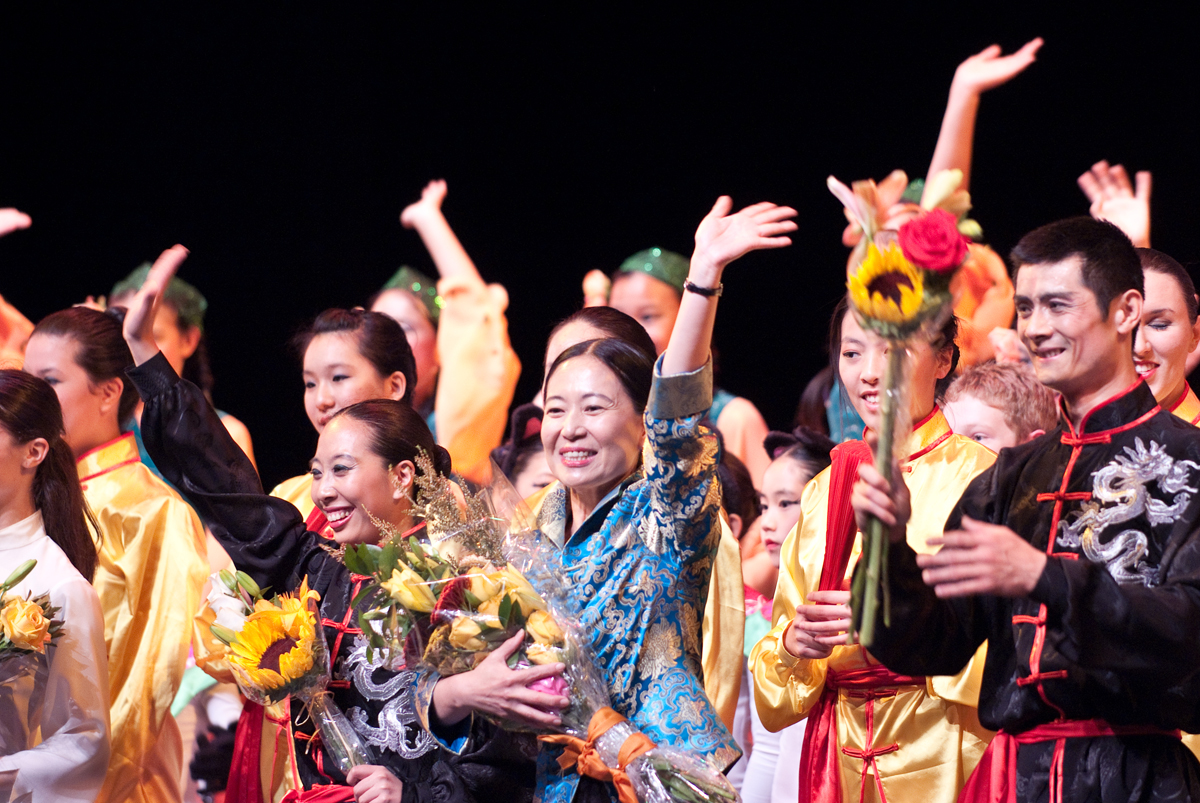
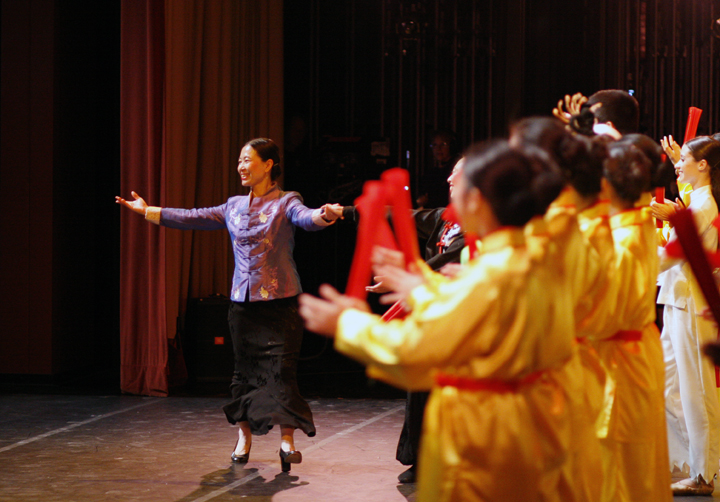
Curtain Call Photos by
Lily Photography (left) and Christine
Zahniser
Introduction
.|.
About
ACDC .|.
Past
Performances
Most
Recent Performance .|.
Upcoming Performance
.|.
Chinese
Dance History
Chinese
Dance Classes
Created by the Atlanta Chinese
Dance Company
Copyright reserved.

 Chinese New
Year is one of the most important celebrations for the Han people. Every
household adorns their living quarters with red lanterns and ribbons, as red is
the symbol of happiness in Chinese culture. It is the most festive time of
year, and celebrations can last for as long as fifteen days. Joyous songs and
dances such as “yangge” create an exhilarating ambiance for all. “Yangge”
originated from farmers’ daily work movements and is the most representative
dance style of the Han Chinese folk people. Typical props of “yangge” include
ribbons, handkerchiefs, silk fans, and scarves. The dance style generally
expresses feelings of happiness. Additionally, big head dolls are often present
at celebrations to heighten the cheerfulness.
Chinese New
Year is one of the most important celebrations for the Han people. Every
household adorns their living quarters with red lanterns and ribbons, as red is
the symbol of happiness in Chinese culture. It is the most festive time of
year, and celebrations can last for as long as fifteen days. Joyous songs and
dances such as “yangge” create an exhilarating ambiance for all. “Yangge”
originated from farmers’ daily work movements and is the most representative
dance style of the Han Chinese folk people. Typical props of “yangge” include
ribbons, handkerchiefs, silk fans, and scarves. The dance style generally
expresses feelings of happiness. Additionally, big head dolls are often present
at celebrations to heighten the cheerfulness. The Tibetan
people are one of
The Tibetan
people are one of %20-%20CZ.jpg)
%20-%20CZ.jpg)
%20-%20CZ.jpg) One
of China’s fifty-five minority ethnic groups, the Uyghur people live primarily
in the Xinjiang Autonomous Region in northwest China. Because of their close
proximity to the
One
of China’s fifty-five minority ethnic groups, the Uyghur people live primarily
in the Xinjiang Autonomous Region in northwest China. Because of their close
proximity to the 
 One of
China’s fifty-five minority ethnic groups, the Uyghur people live primarily in
the Xinjiang Autonomous Region in northwest China. Because of their close
proximity to the
One of
China’s fifty-five minority ethnic groups, the Uyghur people live primarily in
the Xinjiang Autonomous Region in northwest China. Because of their close
proximity to the %20-%20CZ.jpg) This Han folk
dance depicts a group of honest, simple folk women enjoying a peaceful life
close the mountains. They gather together to reminisce their past weddings,
thinking back about how shy they were at the time. The choreography of this
dance was a winner of the China Central Television (CCTV) Dance Competition.
This Han folk
dance depicts a group of honest, simple folk women enjoying a peaceful life
close the mountains. They gather together to reminisce their past weddings,
thinking back about how shy they were at the time. The choreography of this
dance was a winner of the China Central Television (CCTV) Dance Competition.
 Chinese
classical dance originated primarily from Chinese opera and ancient mural
paintings. Dance scholars carefully researched these paintings and created
dance movements to imitate them. This Chinese classical dance piece
incorporates western dance styles such as ballet and modern dance. The
movements, while still rich in the Han classical dance tradition, are more
exaggerated and free.
Chinese
classical dance originated primarily from Chinese opera and ancient mural
paintings. Dance scholars carefully researched these paintings and created
dance movements to imitate them. This Chinese classical dance piece
incorporates western dance styles such as ballet and modern dance. The
movements, while still rich in the Han classical dance tradition, are more
exaggerated and free.
%20-%20CZ.jpg)
%20-%20CZ.jpg)
%20-%20RN.jpg)
 Chinese
ballet is a fusion of classical ballet technique with Chinese dance and opera
movement. In the 1950s, Russian artists brought Russian ballet training to
China and assimilated it with the Chinese training program for dancers. In
addition to performing classical ballets such as
Chinese
ballet is a fusion of classical ballet technique with Chinese dance and opera
movement. In the 1950s, Russian artists brought Russian ballet training to
China and assimilated it with the Chinese training program for dancers. In
addition to performing classical ballets such as %20-%20RN.jpg)
%20-%20RN.jpg)
%20-%20CZ.jpg)
%20-%20RN.jpg)
%20-%20CZ.jpg)
%20-%20RN.jpg)

 “Cradle,”
choreographed to music from the Chinese movie Xiao Hua (1980), depicts a
young pregnant woman full of hope at the dawn of a new
“Cradle,”
choreographed to music from the Chinese movie Xiao Hua (1980), depicts a
young pregnant woman full of hope at the dawn of a new %20-%20CZ.jpg)
%20-%20CZ.jpg)
%20-%20DJ.jpg) This piece was
inspired by Amy Tan’s Sagwa, the Chinese Siamese Cat (2001), an
educational animated series on PBS Kids enjoyed by viewers all across the United
States. It is a breakthrough moment for a Chinese-American author to premiere
an animated series based on Chinese history on a major television network. In
this dance a group of cats are playing a Chinese game called “ti jian zi,” which
is a Chinese hacky sack. Sagwa wants to join in the fun, but the cats shoo her
away. When one of the cats falls down a cliff, Sagwa rushes to rescue her. The
cats are very grateful for her help and they all become “hao peng you,” or good
friends.
This piece was
inspired by Amy Tan’s Sagwa, the Chinese Siamese Cat (2001), an
educational animated series on PBS Kids enjoyed by viewers all across the United
States. It is a breakthrough moment for a Chinese-American author to premiere
an animated series based on Chinese history on a major television network. In
this dance a group of cats are playing a Chinese game called “ti jian zi,” which
is a Chinese hacky sack. Sagwa wants to join in the fun, but the cats shoo her
away. When one of the cats falls down a cliff, Sagwa rushes to rescue her. The
cats are very grateful for her help and they all become “hao peng you,” or good
friends.%20-%20CZ.jpg)
%20-%20CZ.jpg) This
piece was choreographed to music from Crouching Tiger, Hidden Dragon
(2000) and House of Flying Daggers (2004), two popular, critically
acclaimed Chinese movies in the
This
piece was choreographed to music from Crouching Tiger, Hidden Dragon
(2000) and House of Flying Daggers (2004), two popular, critically
acclaimed Chinese movies in the  “Mo
Li Hua,” or jasmine flower, is the name of a popular Chinese folk song
originating from the
“Mo
Li Hua,” or jasmine flower, is the name of a popular Chinese folk song
originating from the %20-%20LS.jpg)
%20-%20CZ.jpg) China’s
Terracotta Army, the mausoleum of the first Qin Dynasty emperor containing
thousands of life-sized soldiers, chariots, and horses buried underground, is
one of China’s most famous landmarks located in Xian in the Shaanxi province.
Often called the Eighth Wonder of the Ancient World, the army has attracted a
lot of attention in the United States. Atlanta’s High Museum of the Art ran an
exhibition called The First Emperor: China’s Terracotta Army (2008), and
New York’s Metropolitan Opera premiered an opera called The First Emperor
(2006). This dance is a Tao Li Bei Dance Competition award-winning solo
inspired by these legendary terracotta warriors.
China’s
Terracotta Army, the mausoleum of the first Qin Dynasty emperor containing
thousands of life-sized soldiers, chariots, and horses buried underground, is
one of China’s most famous landmarks located in Xian in the Shaanxi province.
Often called the Eighth Wonder of the Ancient World, the army has attracted a
lot of attention in the United States. Atlanta’s High Museum of the Art ran an
exhibition called The First Emperor: China’s Terracotta Army (2008), and
New York’s Metropolitan Opera premiered an opera called The First Emperor
(2006). This dance is a Tao Li Bei Dance Competition award-winning solo
inspired by these legendary terracotta warriors.%20-%20CZ.jpg)
%20-%20CZ.jpg)
%20-%20CZ.jpg)
%20-%20LS.jpg)

